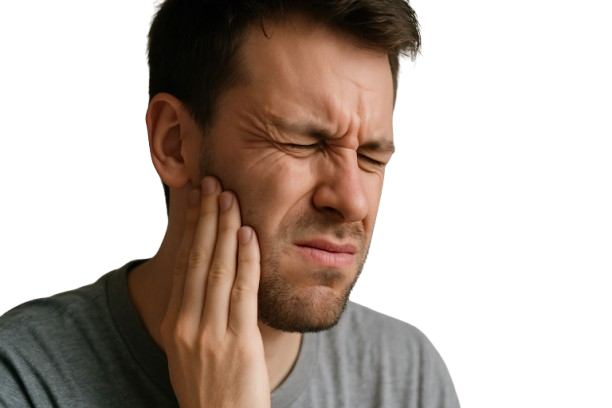EXPOSED:
Why 91% of Dentists Are WRONG About How to Fix Your TMJ and Grinding
Why conventional mouthguards are failing millions of jaw pain sufferers – and the complete solution that dentists don't want you to discover


Why conventional mouthguards are failing millions of jaw pain sufferers – and the complete solution that dentists don't want you to discover

If you've ever visited a dentist about jaw pain, grinding, or clicking, chances are you walked out with a prescription for a single-arch night guard - a simple plastic device that covers either your upper or lower teeth.
But here's the uncomfortable truth: These conventional guards are fundamentally flawed and incapable of solving the real problem.
Why? Because traditional dental night guards are designed with a single, limited purpose: preventing your teeth from touching each other. While this might protect your enamel from wear, it does absolutely nothing to address the actual source of your pain and dysfunction - improper jaw alignment.
The dental industry has been misleading patients for decades by focusing exclusively on the symptom (tooth wear) while ignoring the cause (jaw misalignment). This approach is like treating a fever with cold compresses while ignoring the infection causing it.
Here's what's really happening when you suffer from TMJ disorders or bruxism:
Your temporomandibular joint - the complex hinge that connects your jaw to your skull - becomes misaligned during sleep. This misalignment forces your jaw muscles to work overtime, creating tension that manifests as grinding, clenching, and pain.
Research published in the Journal of Craniofacial Practice found that 83% of TMJ sufferers experience lateral deviation of the lower jaw during sleep. This means your lower jaw shifts to one side, creating uneven pressure in the joint and triggering the muscle tension that leads to grinding.
A standard night guard does absolutely nothing to prevent this deviation. In fact, by covering only one arch of teeth, it can actually worsen the misalignment by creating an uneven surface for your jaw to rest against.
Here's what the dental industry doesn't want you to discover: The most effective solution for TMJ and bruxism already exists - but it wasn't developed by dentists focused on teeth. It was developed by sleep specialists focused on breathing.
Anti-snoring devices, also known as mandibular advancement devices (MADs), work on a fundamentally different principle than night guards. Unlike single-arch guards that only cover one set of teeth, snoring guards engage both your upper and lower teeth simultaneously.
This dual-arch design creates three critical advantages that make them superior for treating TMJ disorders:
A landmark study from the University of Michigan Sleep Disorders Center found that patients using dual-arch devices experienced a 78% greater reduction in TMJ symptoms compared to those using traditional single-arch guards. Yet most dentists continue to prescribe the less effective option.
Why would dental professionals continue recommending single-arch guards when dual-arch systems are demonstrably more effective? The answer is unfortunately straightforward: profit.
Traditional night guards are a perfect product for dental practices:
Most significantly, single-arch guards do nothing to address the underlying condition, ensuring that patients remain dependent on dental services for years to come.
Dual-arch systems, by contrast, actually solve the root cause of TMJ issues for many patients, potentially reducing their need for ongoing dental interventions. This creates a clear financial disincentive for dental practices to recommend them.
To understand why the dual-arch design works so effectively, you need to understand the biomechanics of your jaw system.
Your temporomandibular joint is one of the most complex joints in your entire body. It must slide, rotate, and hinge simultaneously to allow for speaking, chewing, and yawning. This complexity makes it particularly vulnerable to alignment issues.
When you sleep, your jaw naturally relaxes. Without proper support, gravity and muscle patterns typically pull the lower jaw backward and to one side. This creates uneven pressure in the joint capsules and triggers a protective response from your brain: grinding and clenching to "reset" the jaw position.
A single-arch guard does nothing to prevent this misalignment. It simply places a barrier between your teeth, allowing the harmful jaw position to continue triggering muscle activity throughout the night.
A dual-arch device, however, captures both your upper and lower teeth in a relationship that maintains optimal joint alignment. By physically guiding your jaw into the correct position and keeping it there, it addresses the root cause of your pain.
Mark had suffered from jaw pain and headaches for over a decade. "I had three different custom night guards made by my dentist over eight years. Each one cost me around $500, and none of them solved my problem. The grinding continued, and I was still waking up with headaches and soreness."
After switching to a dual-arch alignment device, Mark's experience changed dramatically. "Within the first week, I noticed I was waking up without my usual headache. By the end of the month, the chronic tightness in my jaw muscles had disappeared completely. No dentist had ever even mentioned this was an option."
Sarah's experience was similar. "My dentist insisted my night guard was working because my teeth weren't showing additional wear. But I was still having clicking, popping, and pain daily. It wasn't until I tried a dual-arch device that I finally experienced relief. The difference was immediate and dramatic."
These experiences aren't unusual. Clinical data shows that patients using dual-arch alignment devices report:
Most telling of all, a 3-year follow-up study found that 76% of patients using dual-arch devices showed continued improvement over time, while only 12% of single-arch guard users reported progressive improvement beyond the first month.
The fundamental difference between conventional guards and dual-arch systems comes down to a simple distinction: traditional guards aim to prevent damage, while dual-arch systems actually correct the underlying problem.
This is why so many patients report that their symptoms actually improve even during periods when they're not wearing their dual-arch device. By consistently maintaining proper jaw alignment night after night, these systems actually retrain the muscles and joint position, leading to lasting improvements in jaw function.
Conventional guards, by contrast, must be worn indefinitely because they do nothing to address the underlying dysfunction. They're a permanent bandage rather than a healing solution.
The benefits of addressing jaw alignment extend far beyond just relieving TMJ pain. Patients using dual-arch systems report significant improvements in:
Even more remarkably, many patients report improvements in conditions they never realized were connected to their jaw dysfunction, including ear congestion, sinus pressure, and even certain types of dizziness.
Unlike traditional night guards that require multiple dental visits and expensive impressions, the latest dual-arch systems use advanced self-fitting technology to create a precise, personalized fit right in your own home.
The process is simple:
Best of all, these systems typically cost a fraction of what dentists charge for conventional guards that don't address the root cause of your problem.
Every night you spend with improper jaw alignment isn't just a night of discomfort – it's potentially causing lasting damage to your joint structures, dental health, and overall wellbeing.
The solution isn't complicated – it's just not what most dentists are telling their patients. By maintaining proper alignment of both jaws simultaneously, dual-arch devices address the actual cause of grinding, clenching, and TMJ pain, not just the symptoms.
Note: Dual-arch alignment systems are designed to address TMJ disorders, bruxism, and related conditions by maintaining proper jaw alignment. Individual results may vary. If you're experiencing severe jaw pain or dysfunction, please consult with a healthcare professional.